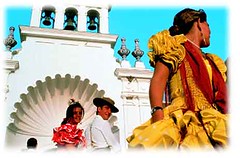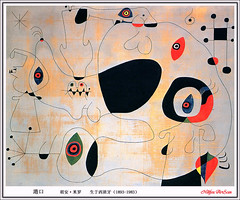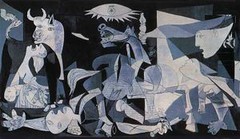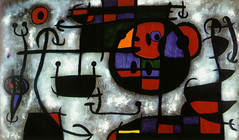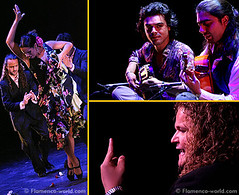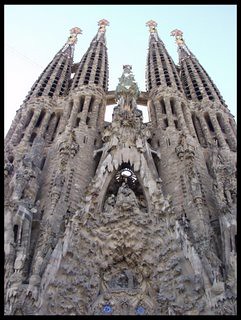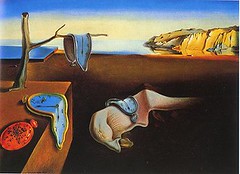Interior of the Mezquita
Mezquita, (from Arabic "
Masjid"), is Spanish for "
mosque". This article deals with the one in
Cordoba, Spain. It is a
10th century Moorish Islamic house of prayer. The site is older than the building, having been host to a
Roman pagan temple, the cathedral church of St
Vincent of Saragossa built by the Catholic bishops under Visigothic rule, and finally the Mezquita itself. Within is a
Renaissance cathedral, built by the
Christian conquerors in the early
13th century. The construction of the Mezquita lasted for over two centuries, starting in 784 A.D. under the supervision of the
emir of Cordoba,
Abd ar-Rahman I. The Mosque underwent numerous subsequent changes:
Abd ar-Rahman III ordered a new minaret, while
Al-Hakam II, in 961, enlarged the plan of the building and enriched the
mihrab. The last of the reforms was carried out by
Al-Mansur Ibn Abi Aamir in 987. It was the most magnificent of the more than 1,000 mosques in the city. The city in which it was built was subject to frequent invasion, and each conquering wave added their own mark to the architecture. The building is most notable for its

giant arches, with over 1,000 columns of
jasper,
onyx,
marble, and
granite. These were made from pieces of the Roman temple which had occupied the site previously, as well as other destroyed Roman buildings. Besides the horseshoe-topped arches, the Mezquita also features richly gilded prayer niches. It reached its current dimensions in 987 with the completion of the outer naves and orange tree courtyard. 伊斯蘭教的寺廟,不准有神像,偶像或雕塑.只能用幾何圖形與阿拉伯

文字,利用不同對稱圖案,借助雕工,構成讓人為之驚嘆動容的原素.建立出完美的寺院建築!哥多華的大清真寺;據說天主教攻佔後,皇帝下令建築師拆掉,要蓋大的哥德式教堂.當建築師見到大清真寺建築的偉大時,就慢慢拆去寺院的柱子.當皇帝生氣為何如此慢,親自入內察看,看到如此華麗雄偉的建築後,反過來,罵建築師見此偉大建築,為何忍心破壞.所以才有,後來回教與天主教兼容並蓄的完美建築作品呈現.(左上圖筆者攝於大清真寺中庭後為雄偉高大的拜樓以前一天六次敲鐘教人民朝麥加方向朝拜)
Interior courtyard of the Mezquita, CordobaThe very year (1236) that Cordoba was recaptured from the Moors, by King
Ferdinand III of  Castile
Castile and rejoined
Christendom, the mosque was reconsecrated a Christian church.
Alfonso X oversaw the construction of the Villaviciosa Chapel and the Royal Chapel within the structure of the mosque. The kings who followed added further Christian features:
Enrique II rebuilt the Chapel in the
14th century, and a
nave was constructed with the patronage of
Carlos V, King of a united Spain. Artisans and architects continued to improve on the existing structure until the late
18th century.大清真寺進入前,有一很大的橘園中庭(見中圖),入寺前回教徒用水先淨身.中庭也有避暑清涼用途,當輕風吹來,陣陣橘香讓人心曠神宜,肅穆敬虔.右下圖為筆者夫婦於猶太區百花巷弄留影,後是大清真寺的拜樓.









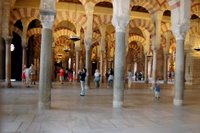















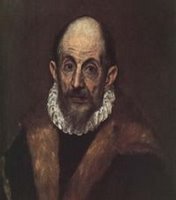


 從此以後,El Greco聲名大噪,忙於繪製西班牙各地教堂的祭壇畫及建築雕刻。而從這時期起,他漸漸喜歡描繪人數少的大人物像,畫風則愈趨奔放。開始繪肖像畫時,因為要求酷像,他忠於現實,以表現他卓絕的寫實主義;但若要表現人物精神內涵,他則採用大膽的變形手法,而愈至晚年愈益強調他理想主義的傾向。El Greco的畫,由於風格獨特,自成一家,不管人物景象都與原形不符,創出令人怵目驚心、卻一見難忘的畫面。人物的身體被變形得極為瘦長,狂熱地扭曲身軀,極富於動勢,表現出他所謂「輝煌的狂態,天上的狂氣」。人像的長身化,依據他在裁判庭上的證言,是因「矮小在所有的造型上最糟的條件」,同時也是基於El Greco拜占庭式的美學主張。El Greco繪畫中常可以看見人物站立在低的地面,以廣闊的天空作為背景,洋溢著人類渴望天界,超越世俗的願望。我們可以在文藝復興時期,藝術走向世俗化的傾向中,看到異色的、神秘的境界。 「聖母升天」(1577年)也是他的名作.<右上圖>
從此以後,El Greco聲名大噪,忙於繪製西班牙各地教堂的祭壇畫及建築雕刻。而從這時期起,他漸漸喜歡描繪人數少的大人物像,畫風則愈趨奔放。開始繪肖像畫時,因為要求酷像,他忠於現實,以表現他卓絕的寫實主義;但若要表現人物精神內涵,他則採用大膽的變形手法,而愈至晚年愈益強調他理想主義的傾向。El Greco的畫,由於風格獨特,自成一家,不管人物景象都與原形不符,創出令人怵目驚心、卻一見難忘的畫面。人物的身體被變形得極為瘦長,狂熱地扭曲身軀,極富於動勢,表現出他所謂「輝煌的狂態,天上的狂氣」。人像的長身化,依據他在裁判庭上的證言,是因「矮小在所有的造型上最糟的條件」,同時也是基於El Greco拜占庭式的美學主張。El Greco繪畫中常可以看見人物站立在低的地面,以廣闊的天空作為背景,洋溢著人類渴望天界,超越世俗的願望。我們可以在文藝復興時期,藝術走向世俗化的傾向中,看到異色的、神秘的境界。 「聖母升天」(1577年)也是他的名作.<右上圖>

